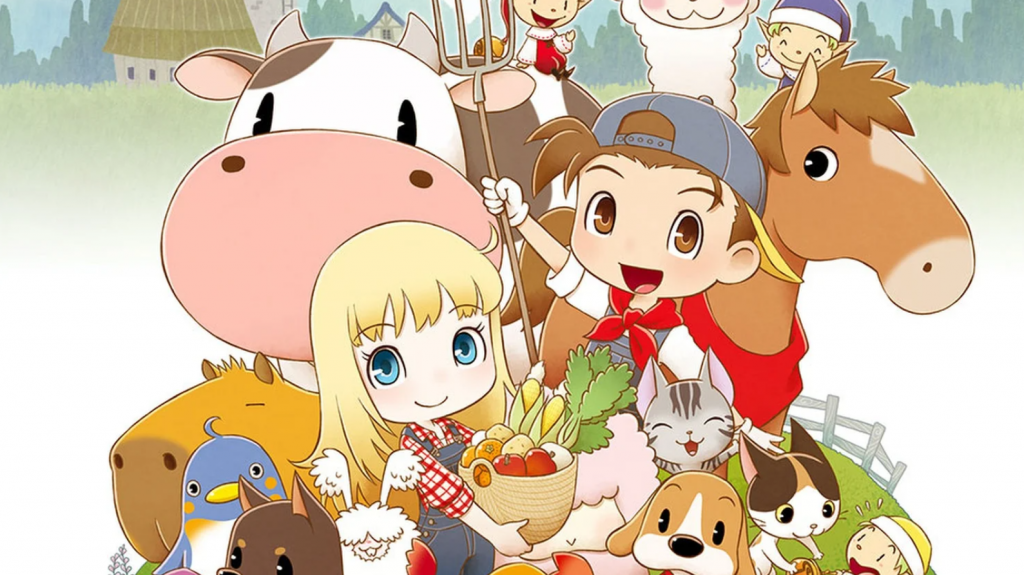
Story of Seasons: Friends of Mineral Town: sweet, simple and satisfying
As soon as I hit the title screen, my heart fluttered. It was the same song I had heard far too often growing up. The same song I’ve whistled around the house countless times and the same song that graced both 1999s Harvest Moon: Back to Nature and 2003s Harvest Moon: Friends of Mineral Town start screen. While the title of the game has changed, Marvelous’ Story of Seasons: Friends of Mineral Town is not merely a successor to these beloved games, but a “reimagining”- as listed on their marketing page. The game contains the same map, story, songs, characters, and interactions, and I was getting the privilege to play it on my Switch in 2020. I was instantly enamored.
The game starts the way these things so often do- with you inheriting your grandfather’s derelict farm. You move in and are promptly greeted by the town’s mayor, who seeks to get you started on your mission of restoring the farm to its former glory and making a name for yourself in this provincial town. Once the introductions are over, you are left to your own devices as you decide how you’d like to manage the approximately ten real-time minutes allotted for each in-game day. Whether you focus on foraging, mining, cooking, and fishing, or dedicate the bulk of your time to tending to your fields and flocks, gathering resources to upgrade your land, and finding the perfect gifts for your perfect partner, it’s all up to you. The game has no true ending, but instead allows you to play endlessly as you unlock achievements commemorating your successes- whether they be as small as upgrading your tools or as monumental as having a child.
A calendar in your home marks important occasions and the birthdays of various townspeople- attending these events and gifting beloved items to your neighbors improves your relationships with them and unlocks new scenes and dialogue. As you strengthen your relationships, you’ll notice twelve of Mineral Town’s residents have a heart gauge on the dialogue box. The heart will brighten as you win them over, going from pitch black to a vibrant red when they are willing to marry you. The game encourages you to take your time, date all of those you are interested in, and truly find which partner best suits you, however, if you wait too long to woo, a rival will win over the heart of each eligible bachelor and bachelorette.

On your farm, you can break down stone and wood to upgrade your buildings, build up your tools so you can upgrade them using various ore, purchase livestock, practice your cooking (once your house is upgraded, of course) and, quite naturally, farm. In the woods and mountains surrounding Mineral Town, spirits and sprites inhabit the world that seemingly never runs out of little secrets and quirks, and honestly, from here on out, it’s better you go on and experience it for yourself. Or religiously use a walkthrough like I did. Back in 1999, my Back to Nature Prima (complete with the saying “chicks dig farmers” in giant letters on the back) was my most prized possession- how else would I win the heart of my girl Karen?
Mechanically, the game excels and the Switch truly is a great home for Story of Seasons: Friends of Mineral Town. The default button mapping suits the game (though you can adjust it) and I can very comfortably say that after playing probably half a dozen Harvest Moon titles, this iteration is the most streamlined and intuitive to interact with. While accessibility is a bit lacking (no options for colorblindness, font size adjustment, limited auditory cues, etc.), prior to the game’s start, it does offer you two ways to play- one starts you off with a small patch of turnips and expedites the rate in which you build relationships and earn money while the other offers a more traditional and slightly more challenging experience. For those who have never played a Harvest Moon or Story of Seasons title, the jump start is a great way to acclimate and allows you to relax a bit more as you progress.
The gameplay loop is sweet, simple, and satisfying and all in all, the game feels great to play. New players will be charmed and old players will, such as myself, get that sweet dopamine hit of nostalgia. However, I think it’s important to jump back to the idea of this game being a “reimagining” of Harvest Moon: Friends of Mineral Town and to examine how much the game’s vision has changed the past seventeen years.
Unfortunately, this is where I found the majority of my issues with Story of Seasons: Friends of Mineral Town. Marvelous’ reimagining lacks, well, reimagining. There are some slight dialogue changes and naturally the game’s cutesy, chibi-esque art has been lovingly updated for the Switch, but by-and-large, the game is identical to the 2003 title it draws upon. Where it deviates the most is in it’s romantic relationships.

First and foremost, the Friends of Mineral Town throws two new potential partners into the mix, both of which I swear I met in one of my Freshman political science courses. Their names? Brandon and Jennifer. Brandon is a renowned artist with a cold demeanor and the wardrobe of a mid 2000s alternative frontman, while Jennifer is a free-spirited flower child who spends the majority of her time simply vibing. Neither feel incorporated into the existing game in a meaningful way, both residing in existing buildings (the inn and the woodworker’s cabin) without much of a tie to other characters and the town itself. While Jennifer alludes to conflict between herself and Carter, the town’s pastor, in the year or so I put into the game this did not manifest into anything greater than her calling him vexing.
In addition, I think part of the reason these characters feel a bit disappointing to me is because of the general lack of diversity in the town. In the game there is one person of color- an eligible bachelor named Kai who visits the town only in the summer to sell fruit and has a reputation for flirting with the town women. Yeah.
All of the game’s potential romantic partners adhere strictly to gender binary, gender norms, and very conventional standards of physical ability and beauty, this culminating in the developers being so attached to certain looks, Jennifer is essentially given Karen’s traditional appearance. They then distinguish the two women by giving Karen—wait for it—bangs (or a fringe, to non-Americans).
The second major change is the addition of gay marriages. In previous titles, gay relationships were simply not permited or were coded as a “Best Friendship.” Despite going into this game having heard same-sex relationships were now included, I was still nervous the entire time I paced about town, wooing Ran with spa-boiled eggs and charming Karen with Moondrop flowers. I couldn’t shake the fear it was all in vain. But the second Karen and I went back to my house to define our relationship and she exited the building with a sly ‘babe,’ I was elated. When she gushed about how great we’d look standing next to each other in wedding dresses? I was over-the-moon. I listed above the ways in which the game still falls behind in being truly progressive, and I think it’s vital to acknowledge them, but it must be said that the inclusion of same-sex relationships is an absolutely incredible feeling. In addition, it makes certain moments—such as the “all girls best friend slumber party”—hilarious.

But outside of these two large relationship changes, the source material remains largely untouched- for better and for worse. When the Harvest Moon games were first released, I think it’s safe to say they were fairly unique. I know I had never played a game quite like Back to Nature when I picked it up back in the late 90s and god, I fell in love instantly. Getting the privilege to go back to Mineral Town, get lost in the somehow delightfully monotonous gameplay, and interact with these characters I know and love was truly magical. However, since then, similar titles have emerged- most notably Chucklefish’s Stardew Valley. After investing countless hours into Stardew Valley, it becomes hard not to compare the two and notice the places where Story of Seasons is a bit lacking.
Whereas Stardew embraces the times and has more modern looking homes, characters who utilize technology/are interested in tech related fields, and an underlying story of how capitalism impacts small towns, Story of Seasons shirks away from it all. Because of this, Mineral Town feels a bit emptier; the streets are mostly desolate, the festivals have generally fewer than 8 people in attendance, the homes aren’t particularly homey, and the intimacy with other characters isn’t quite as exciting or unique. While perhaps you could look at it and be completely content with them sticking to their guns and the idyllic escapism the game offers, I found myself wishing for just a bit more.
That being said, playing Story of Seasons: Friends of Mineral Town leads me to believe more is around the corner. The game did a wonderful job at successfully retaining the gameplay and charm that made so many of us fall in love with it all those years ago while also embracing necessary change – even if it still has a long way to go. The Switch port runs beautifully, and the game truly feels at home on it; it took hardly any time at all for it to replace Animal Crossing: New Horizons as my new favorite pick-up-and-go game due to its goal-oriented and self-paced nature. For those of you looking for a new way to kill time and kiss girls, Mineral Town, and all its friends, are waiting for you.







